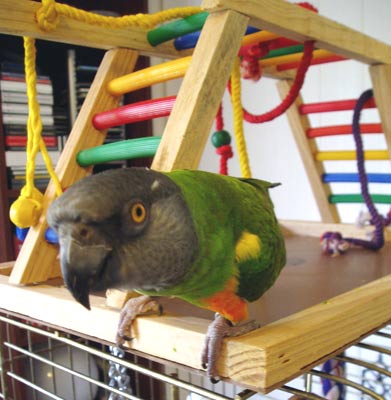The Pleasures of Pet Parrots
Understanding These Exotic Birds Who Have a Long History with Humans

Popular pets admired for their bright colors and intelligence, parrots are considered very “exotic.” However, parrots have actually been pets for thousands of years.
The term “parrot” includes a variety of birds with distinctive, common features: strong, curved beaks, an upright posture, clawed feet, intelligence, and often very colorful feathers. Parakeets, cockatiels, and lovebirds are some commonly kept as pets, although larger, more exotic species are popular too, including Amazons, African greys, and cockatoos. However, these represent only a few of nearly 400 parrot species.
Parrots have been diversifying for tens of millions of years across the globe. Fifty million years ago, the first distinctly parrot-like birds appeared, developing a “modern” appearance 20 million years ago. Parrots today come in an astounding array. Life-spans vary greatly; macaws at around 100 years are a very long-lived pet, while parakeets are one of the shortest-lived parrots, averaging around 8 years. The largest parrot, the hyacinth macaw, reaches over three feet long, while the smallest, the buff-faced pygmy parrot, is only 3.4 inches long. Parrots include some of the most intelligent birds, rivaling the corvidae family (crows, ravens, and jays), as shown by two famous African greys: Alex, who associated words with their meanings and identified 50 objects, and N’kisi, who has a vocabulary of over 950 words, using many in proper context.
Early humans in Asia and Australia were exposed to a variety of parrots. Among others, cockatiels, ringnecks, parakeets, and rosellas all live in Australia. In Southeast Asia and Australia, lorikeets and cockatoos abound. Lories, pygmy parrots, fig parrots, hanging parrots, and others are more restricted to Southeast Asia only. In India and Southeast Asia, parakeet varieties, including the ring-necked parakeet and the Alexandrine parakeet, exist.
Asian parrots made their way to Europe through trade and conquest. One of the first written records of parrots is in an ancient Indian text, the Rig Veda, in 1000 BC. Undoubtedly, other Asian cultures had also encountered, and possibly made pets of, local parrots. By 500 BC, talking birds were in Persia. The first Europeans wrote about parrots in 397 BC; the Greek Ctesia described how a plum-headed parakeet could “speak.” Soon after, in his History of Animals, Aristotle (385-322 BC) described a parrot, most likely a parakeet, called Psittacae, now the name of the true parrot family (Psittacidae). A great influx of parrots from India followed its invasion by Alexander the Great in 327 BC; he brought back several parrot specimens which soon became quite popular in Greece.
Like the culture, parrots spread to Rome from Greece with its Roman conquest in 146 BC. Along with Asian parrots, African parrots made their way into Roman trade. A variety of parrots can be found in forests throughout Africa, including ring-necked parakeets, Senegals, African greys, and lovebirds. Madagascar is also home to lovebirds, other parrot species, and countless other fascinating animals found nowhere else. Kept as fancy pets by aristocrats, in Rome parrots were admired in beautiful cages and attended to by household slaves. However, parrots were also consumed in Rome; they were considered a delicacy and occasionally fed to lions.
Although Roman trade spread parrots throughout Europe, once the Roman Empire fell in the 400s AD, interest in these exotic birds declined. However, they were still occasionally kept by wealthy Europeans: Holy Roman Emperor Frederick II had a prized umbrella cockatoo, a gift from the Babylonian sultan in 1220 AD; Pope Martin V (1417-1431) appointed traveling servants just to care for the highly valued creatures; and King Henry VIII of England (1491-1547 AD) kept a beloved African grey parrot.
When Europeans began their conquest of the Americas, they not only brought back gems and chocolate, but also American parrots, novelties in Europe. Throughout South America, Central America, and the Caribbean islands, there are a variety of parrots, including macaws, parakeets, Amazon parrots, and conures, of all shapes and sizes. Some have more limited ranges; parrotlets are only in South America and thick-billed parrots in Central America exclusively. American natives were well aware of the parrots in their area millennia before Europeans arrived; 5,000-year-old cave paintings of macaws in Brazil and parrot drawings from 100 to 800 AD in Peru (the Nazca geoglyphs) exist. There are even macaw remains and petroglyphs in Anasazi areas in New Mexico, such as Chaco Canyon, suggesting parrot trade from the Toltecs of Mexico to the Anasazi around 600 AD to 1100 AD.
When Christopher Columbus returned from the Americas in 1493 with a pair of Cuban Amazon parrots for his patron, Queen Isabella of Spain, popular interest in parrots was renewed. Portuguese traveled far to bring back huge numbers of exotic birds, making parrots available to more than just aristocrats. Bird shows became common in the 1600s AD in Europe. With the European conquest of Australia, a new parrot group became admired in Europe; “budgies,” commonly sold as parakeets in U.S. pet stores, were brought to England in the 1800s.
Parrots have continued to be quite popular, and, despite thousands of years of “domestication,” are still considered exotic pets. In 1992, the “Wild Bird Conservation Act” ended parrot importation into the United States since wild populations were being decimated. While this increased captive parrot breeding, wild habitats still suffer greatly; within 50 years, only an estimated 5 percent of current parrot habitat will remain “protected.” The most expensive parrots, including some cockatoos and Amazons, can cost more than $10,000 due to captive breeding difficulties.
However, many parrots are more affordable and accessible than ever. Many less-common parrots make great pets: ring-neck parakeets, pionus, caiques, lorikeets, Senegals, and conures. Pet owners must take care as every parrot needs its own, specialized diet; seeds alone can cause an early death, as most parrots need fresh vegetables, fruits, and vitamins (often sold in pellet form). And due to the long life span of these birds, parrot ownership can be a lifelong commitment! However, as a parrot owner you’ll be continuing a millennia-long tradition of admiring these intelligent, beautiful human companions.
For more on parrots, see Animal Hospitals-USA’s “ “Bird History as Pets: Brief History of Birds as Pets”,” Avian Enrichment’s ““Parrots in History”,” AvianWeb’s ““Parrot Species Index”,” Wikipedia’s ““Parrot”,” Parrot-and-Conure-World’s ““Parrot Species Comparison Chart: Compare the Most Popular Parrot Species!”,” Bruce Thomas Boehrer’s Parrot Culture: Our 2500-Year-Long Fascination with the World’s Most Talkative Bird, Paul Carter’s Parrot, and Tony Juniper and Mike Parr’s Parrots: A Guide to Parrots of the World.
Biology Bytes author Teisha Rowland is a science writer, blogger at All Things Stem Cell, and graduate student in molecular, cellular, and developmental biology at UCSB, where she studies stem cells. Send any ideas for future columns to her at science@independent.com.



